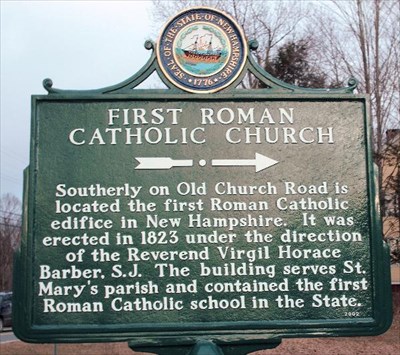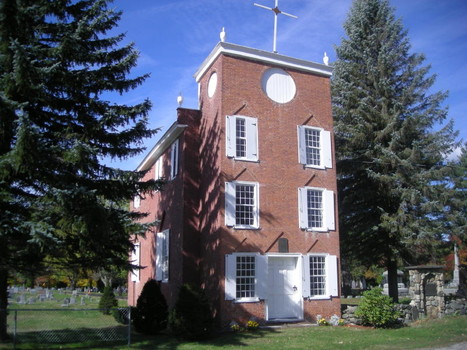 Old St. Mary's, Old Church Rd., Claremont
Old St. Mary's, Old Church Rd., Claremont
Old St. Mary Church in Claremont, New Hampshire, is the first Roman Catholic Church in the state.
The original building was erected in 1823 under the direction of the Reverend Virgil Horace Barber, S.J. It is located in West Claremont on Old Church Road. The building served St. Mary's parish and contained the first Roman Catholic school in the state.
The unusual two-story brick building was erected at the north end of the Barber home and next to what was then the only cemetery in Claremont. The contractor was Andrew Comings (1776-1853) of Cornish, and when finished in 1824, the sanctuary and its gallery had above it a large "study room" and "two small rooms for the classes." The church is twenty feet by forty-eight feet, six inches (including the sixteen by eight-foot front section), and thirty-four feet to the eaves. The main part of the Barber house was probably twenty-one by forty-two feet in size. The church was directly accessible from the adjoining house, where Virgil opened the Claremont Catholic Seminary in the autumn of 1823. It was the first Catholic boys' school in New England, and was for some students a preparatory college for the Jesuits. The term "seminary" was often used in the 19th century as we now use the term "high school."
The church was regularly used until 1866, but was rarely in good repair. Although it was put up for sale, it never sold. Late in the 19th century, old furnishings from the new  Church were placed in Old St. Mary's--pews, reed organ and an altar. Also, the walls were repaired and the church was rendered habitable. Fr. Simard began the practice of an annual Mass there in 1905. The church also served as a storage place for cemetery equipment.
Church were placed in Old St. Mary's--pews, reed organ and an altar. Also, the walls were repaired and the church was rendered habitable. Fr. Simard began the practice of an annual Mass there in 1905. The church also served as a storage place for cemetery equipment.
Daniel Barber's house was rented out and apartments were often occupied by immigrants. By 1914 the Barber house was demolished. In 1921 a new brick wall at the rear of the left side of the church was built, where the Barber home had been attached. A small door on the left side of the entrance was bricked up. Also, two windows that match those on the other side were added, along with a new roof and eaves, turnbuckles and rods through the classroom to stabilize the side walls, plastering and painting. The staircase from the gallery to the classrooms was altered, and may not have been part of the original floor plan.
By 1939, the Knights of Columbus made some repairs and had a bronze plaque placed over the door. In 1942, the present pews were given and in 1948 the altar was given, as well as new roofing. The building had no electricity until 1965. In 1964-65, the Knights of Columbus gave funds for renovations.
In 1949, Fr. Buckley began the tradition of Saturday morning Masses during the summer, "...in order to increase visitational devotion to that of a shrine." After a lapse, the practice was revived by Fr. LaMontagne and has not ceased to this day.
Old St. Mary's is the second oldest Catholic structure standing in New England.
 St. Mary Church, Central St., Claremont
St. Mary Church, Central St., Claremont
The present church building on Central Street, Claremont, New Hampshire, was erected in 1870 through 1873 and the first Holy Mass was celebrated in the new church in October of 1871. The church was remodeled in 1881 and rededicated in the year 1884. The bells were installed in 1881.
The Bishop obtained the first pastor for the re-established parish, Fr. Derome, from the Diocese of Saint-Hyacinthe, Quebec. He returned to Quebec in 1872. A number of pastors filled in briefly before Fr. O'Sullivan arrived in 1873 and stayed until May 1881. After this Fr. Finnigan arrived and remained until February 1901. During his stay, many improvements were made to the church.
In 1889 the original 137 foot steeple was replaced with a new 150 foot steeple greatly altered in appearance with the addition of Beckwith Gothic "gingerbread". A superb peal of three bells was blessed on the ground by Bishop Bradley on October 13, 1889, when he came to confirm 152 persons before a congregation too large for the building. The bells were first heard on October 20, and were rung for many years by ropes rather inconveniently located in the unventilated area behind the organ. Also in the 1880's, electric lights and telephones arrived.
Additional buildings were purchased. In 1883 the first of four Greek Revival houses was purchased, which was used as a Convent and is now used as the Rectory. In 1885 the school building was purchased and St. Mary School opened in 1890. In 1889 the first rectory became the Convent. In 1897 a fourth building was purchased and used as a high school until it was torn down in 1958. In 1938 a former Methodist Church was purchased and became a gym until it was destroyed by fire in 1946. In 1948 the present gym was built. In 1948 the house next to the gym was dedicated as the Catechetical Center, "The Annex", was used for classes prior to a new high school opening in 1957.
A lasting memorial to the Finnigan years, and the only piece of 19th century furniture left in the church, is the pipe organ, which cost a little over $2,500 dollars! It was purchased in 1895. The replacement value today is more than a quarter million.
On Easter Sunday, April 20, 2014, at 2:30 AM, the Convent building was on fire and the Fire Department was called in to extinguish the flames. The building, which was vandalized about two years prior, was destroyed. Minor damages to St. Mary School building also resulted from the fire. The cause of the fire is still unknown.
In the fall of 2019, St. Mary Church suffered damage to one of the chimneys and subsequent roof area due to inclement weather. Thanks to Louis MilleƩe we were put in contact with Kerry Gagnon of K.M. Gagnon Inc. who contracted to not only cap off the chimney in time for the winter (which was a miracle in of itself!) but also to restore the chimney and areas of the roof in the spring of 2020 in accordance with its historical architecture, including brickwork and slate shingles.